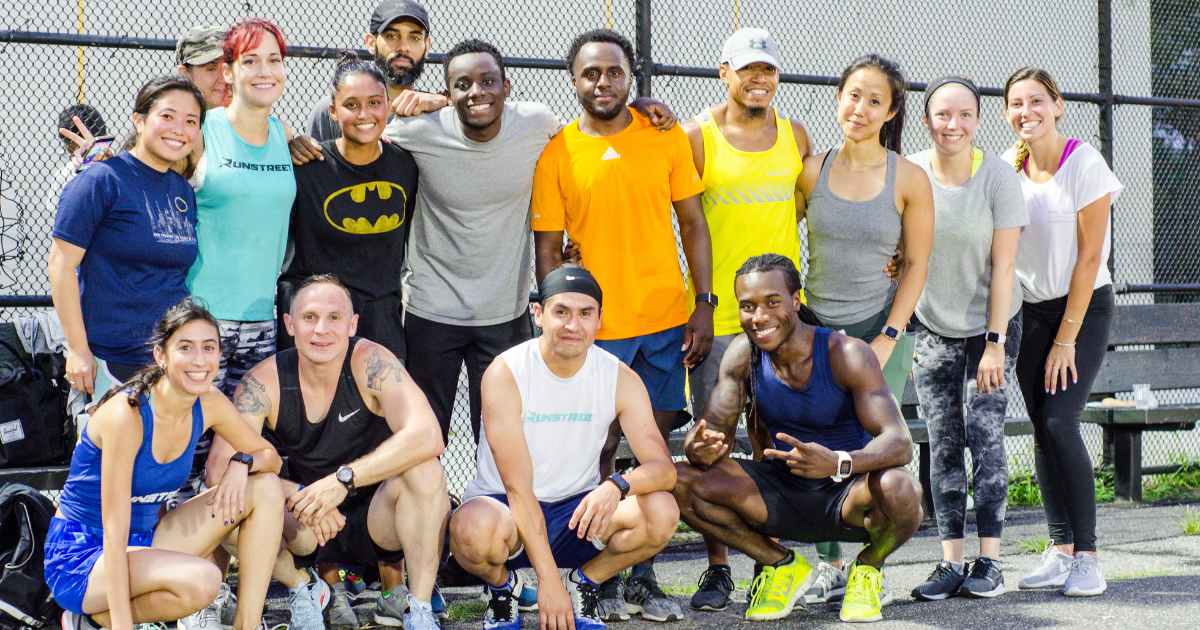Half Marathon Training Plan for Beginning Runners
Photos by Marques Jackson Photography.
By Marnie Kunz, NASM-certified trainer, USATF- RRCA-certified running coach
Following a half marathon training plan will help you go from running recreationally to completing a 13.1-mile race. Whether you’re new to running or are returning after a break, this half marathon training program for beginners 8 week plan will walk you through the steps you need to take to train for and run a half marathon. This guide covers everything you need to know, from picking out the best running shoes to doing long runs and fueling for your race. I’m also including a free beginner’s half marathon plan that will take you from running 5K to running a half marathon in 8 weeks!
Related Post: Best Half Marathon Workouts to Get Faster
How Long Is a Half Marathon: The Basics
A half marathon is 13.1 miles or 21 kilometers. As the name suggests, a half marathon is literally half the distance of a full marathon. This race distance requires a well-planned training program as it requires a lot of endurance to run. It’s not a few miles or kilometers, which some people can wing and do without training.
A good half marathon training program for beginners will increase your weekly mileage gradually to build your endurance and general fitness so you're ready to tackle your first half marathon. Our training program and training tips will help you cross the finish line strong.
Picking a Half Marathon Training Plan
For long-distance races, training plans give you a map to help you plan your workouts and build your endurance. A half marathon training plan is crucial to help you get to the finish line. A training plan designed by a running coach can help minimize your risk of running injuries while improving your cardiovascular fitness and stamina.
Whether you’re a beginner or have been away from running for an extended period, our beginner-friendly 8-week Half Marathon Training Plan will help you build your endurance so you can run 13.1 miles on race day.
If you’re an intermediate or advanced runner or you want to run a faster half marathon than your current pace, check out our Customized Running Training Plan for a personalized program with speed workouts tailored to your fitness level and time goals. We also have 10 Best Speed Workouts for speed training workouts that can help you crush your next half marathon.
What to Wear
Good running shoes are so crucial for training.
When you’re training for a half marathon, you need a few essential pieces of equipment - good running shoes and moisture-wicking running clothes. Here are some tips to help you find the best gear for your training to help you run comfortably and consistently.
Running Shoes
If you don’t already have a pair of running shoes that work well for you, head to your local running store to get fitted. A running store can do a wear test and check out your running gait and foot type to help you find comfortable shoes.
Also, remember that your feet will expand as you run, especially over long distances. Because of this, I usually advise runners I train to get a shoe size that is a half size bigger than their regular size.
Running shoes typically last 300 to 500 miles. If you have worn shoes, you’ll be more likely to feel nagging aches and pains and will be more susceptible to injuries. Change your shoes when they start to feel flat and unsupportive.
Related Post: When to Change Your Running Shoes
Running Clothing
When it comes to running clothes, look for moisture-wicking running shorts, leggings, and tops. Dress in layers to suit the weather so you can take off your top layer if you get too warm. All major sports brands have running clothes made with synthetic, moisture-wicking materials, and this will help keep you dry and comfortable while running.
You don’t have to go all out and buy the most expensive gear. Some basic running shorts or tights and shirts and sports bras will suffice. Look for sweat-wicking materials and clothes that fit comfortably.
Related Post: What to Wear Running: Checklist from a Run Coach
Training with people can boost your motivation.
Training Principles
When you’re following a half marathon training plan, these training principles will help you get in shape and reduce your risk of getting injured:
Long Runs
Long runs are the staple of half marathon training programs. The long run builds your endurance by gradually increasing your running distance. Our half marathon training plan has a weekly long run that will build your endurance over time.
When you do your long runs, go at a very relaxed pace, at your base run pace or slower. You should be able to comfortably keep up a conversation during your long run. Your long runs should feel like an effort level of about 4 to 5 out of 10.
Related Post: RPE Scale Explained
Speed workouts can help you get your best race time.
Speed Workouts
Speed training will help you become a faster runner. For our free 8-Week Half Marathon Training Plan for Beginners, there are no speed workouts since the goal for beginning runners is to build endurance and finish the race. However, for intermediate and advanced runners who have a goal time for race day, speed workouts are essential.
Speed work increases the intensity of your regular runs. They can be steady-state effort runs - called tempo runs - which push you to run at a “comfortably hard” pace. The other type of speed workout is intervals, which include periods of fast running followed by recovery segments. Speed workouts help train your body to run at your goal half marathon pace.
Some especially helpful interval workouts for half marathon runners are Yasso 800s (which are 800-meter or half-mile intervals) and Mile Repeats (1-mile intervals).
Strength Training
Strength training is a crucial part of running that will help your body get stronger and improve your stamina when tackling hills and long runs. I recommend doing at least two strength workouts a week in keeping with the Physical Activity Guidelines for Americans.
You can do full-body strength training with bodyweight exercises, resistance bands, dumbbells, barbells, or weight machines. Two strength training sessions a week will help improve your running form, speed, and stamina and reduce your risk of injuries.
For free strength training workouts, see 10 Best Exercises You Can Do at Home and Strength Training for Runners Guide.
Rest and Recovery
Rest days and recovery sessions will be an integral part of your half marathon training plan. This allows your body time to rebuild so your muscles can recover from hard workouts. Rest days offer an excellent opportunity to take a complete break or to do some light cross-training activities like walking, yoga, or biking.
Whether you're a novice runner or more advances, taking rest days is a crucial part of training. If you have a day during your training where your body feels especially sore or worn down, taking an extra rest day can help prevent injuries and illness and give your body more time to recover.
Tapering
Tapering is when you reduce your training to allow your body to fully recover and hit peak performance on race day. For half marathons, most tapers will be about two weeks. This means you will have shorter, less intense runs during this time.
If you’re preparing for your first race, the taper period is an excellent time to practice some visualization to help prepare your mind for race day. Meditation is also helpful for mental training to relax your mind and reduce pre-race jitters.
Related Post: 6 Tips to Visualize Running Success
Fueling for Half Marathon Training
When you’re training for a long race like a half marathon, nutrition can make or break you. It’s important to eat a variety of fresh foods, choosing complex carbs in the form of whole grains, lean protein foods, and plenty of fruits and vegetables.
You’ll also want to experiment with what you eat before long runs, as you will develop a routine that suits your digestion and energy requirements. Usually, low-fiber, bland foods are best to eat before a long run, such as a peanut butter sandwich on whole wheat bread or plain yogurt and a banana.
During your long runs that last an hour or more, you will also need fuel. Experiment with different running gels until you find a flavor and kind you like. Follow the instructions on the packaging, usually taking a tablet, GU, or gel every 45 minutes to an hour before and during your long runs.
Bring hydration on your long runs, too, and any time you’re training in heat and humidity. A running water bottle or a running backpack with a hydration pack will allow you to easily bring your hydration with you on long runs. Opt for an electrolyte drink or add an electrolyte tablet to your water bottle for optimal hydration on the run.
8-Week Half Marathon Training Plan for Beginners
You can download our free 8-Week Half Marathon Training Plan here. This program will take you from being able to run a 5K to running 13.1 miles (21 kilometers). The plan was designed by a running coach (me!), and I fine-tuned it based on my years of coaching runners for half marathons.
I have included suggested strength training and rest days in the program. The strength workouts are based on my experience as a personal trainer and target your full body. You can personalize the plan to suit your individual schedule.
Just keep in mind that after a long run, you should take a rest day or recovery run the following day. Do not do two hard workouts in a row - so follow hard workouts with easy runs or rest days. If you do a speed workout on Tuesdays and a long run on Thursdays, for instance, take a rest day or easy run on Wednesdays.
For a personalized half marathon training program, head to our Training Center to get a Customized Running Plan. If you try this program, follow and tag @Runstreet on Instagram to let me know how your training and race go. I love to repost and cheer on my runners.
For more training tips and resources, sign up for our mailing list to get our free Wellness Wednesday newsletter delivered ot your inbox.
Happy running to you - you got this!
Related Posts: 10 Long Run Tips from a Run Coach, 15 Best Half Marathons in the World
Marnie Kunz is a NASM-certified trainer and USATF- and RRCA-certified running coach based in Brooklyn, NY. Marnie likes helping people get and stay active to enjoy a better quality of life. When she’s not doing fitness things, Marnie enjoys exploring with her dog, a mischievous rescue Akita.





